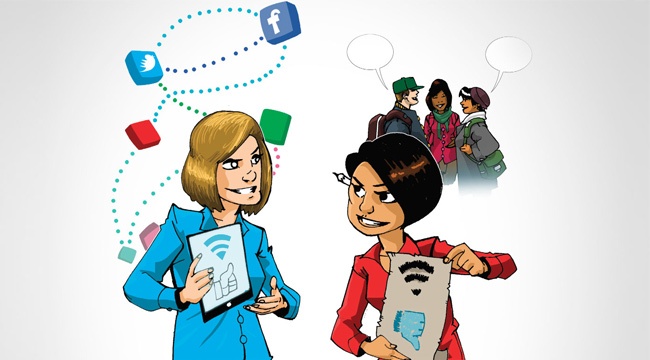Connectivity Clashes
Is technology in classrooms causing a deeper shift in how students learn? How are the Internet and search engines impacting student research skills? Discover the answers in this issue’s debate as two different professors invite us into their classrooms where, in one, technology is embraced and, in the other, less so.
Michele Jacobsen, BEd’93, MSc’95, PhD’98, is dedicated to disrupting common beliefs about teaching. As associate professor in the Werklund School of Education, her area of research focuses on technology-enabled learning and teaching in both real time and online, from K-12 to higher education.
What kind of technological devices and practices do you use in your classroom?
I encourage students to use their mobile devices and laptops during class to capture key ideas, access and share resources and expertise. I am thrilled when students live-tweet ideas and insights in class, or post a reflection or photos on their blog or add articles they have found to our D2L learning space. I tend to experiment with a range of technologies that include Google apps, Dropbox, Twitter, blogs, clickers, mobile apps, web conferencing, wikis, virtual worlds, digital games, video editing and so on.
How has access to online information impacted the teaching profession?
One of my greatest joys is to support students in building upon what is known and to create new knowledge, to contribute new ideas to the discipline and to collaboratively critique and debate existing knowledge and ideas. The professor’s role has expanded from the important task of engaging students in a learning community to also helping students develop digital-literacy strategies for critically assessing the value, relevance and impact of information and ideas.
In what ways can the use of technology improve/detract from teaching and learning?
Conventional brick-and-mortar images of higher-education classrooms with a “sage on the stage” have expanded to include a wide range of technology-enhanced learning experiences. I use the Internet, virtual worlds, social networking and audio or videoconferencing, online publishing and programming to provide support for global conversations beyond class, for digital media and information-sharing and for knowledge-building in community. Students and I use our networked mobile devices, tablets and laptops to access and contribute to blended and online courses, to capture, edit and publish audio, video, images and animations from anywhere and at anytime, and by adding our voices and ideas to online spaces and forums beyond the course so that, as a learning community, we can influence global conversations.
How do you use technology to communicate with students?
I use technology to connect with students who are in Calgary and also around the world. In a course, I set weekly online office hours so students can connect with me synchronously, as well as I set up individual meeting times with students using Skype, Google hangouts, virtual world and the telephone. I use Adobe Connect to hold synchronous online seminars in my classes, and also to meet with my research and teaching teams, and I set a generous timeframe for email inquiries and requests.
In the age of easy access to online information, what has changed in the way students learn?
I hope that widespread online access to information and to each other changes the type of work we design for students in higher education. For example, professors are called upon to be increasingly creative in designing tasks with questions that are not Google-able. Professors, today, should be challenging students to critically inquire and evaluate the knowledge base, to collaborate with others in analyzing and synthesizing knowledge and to forge new ideas and share perspectives on issues, debates and problems that characterize our disciplines, versus simply borrowing and repeating well-worn ideas.
How do you see the classroom changing in the next 15 years?
An ongoing challenge will be to continue to engage with the broader community as part of the ongoing review, design and renewal of our programs so that teaching and learning on campus reflects the disciplinary knowledge, technological advancements and 21st-century competencies that today’s students require to become leaders in a connected world.











